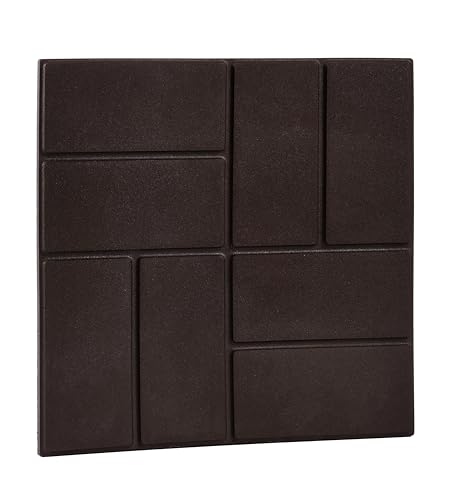When it comes to enhancing our outdoor spaces, choosing the right type of pavers can make a significant difference in both aesthetics and functionality. In our exploration of rubber versus stone pavers, we delve into the unique characteristics and benefits each option offers for landscaping projects.

Rubber pavers, known for their durability and eco-friendly nature, provide a versatile alternative to traditional stone pavers. On the other hand, stone pavers exude a timeless charm and elegance that can elevate the look of any outdoor area.
Join us as we compare the features of rubber and stone pavers to help you make an informed decision for your next landscaping endeavor.
Understanding Pavers: The Basics
What Are Rubber Pavers?
When it comes to outdoor landscaping, rubber pavers offer a versatile and environmentally friendly alternative. Made from recycled tire rubber, these pavers are not only durable but also contribute to sustainability efforts by reusing materials that would otherwise end up in landfills. Our team often recommends rubber pavers for areas where flexibility and slip resistance are key considerations, such as playgrounds or pool decks.
What Are Stone Pavers?
Stone pavers, on the other hand, exude a timeless appeal and bring an element of natural beauty to any outdoor space. Crafted from various types of stone such as limestone, sandstone, or granite, these pavers offer durability and a classic aesthetic that can elevate the look of a patio or walkway. At our design firm, we love incorporating stone pavers into projects where a sophisticated and elegant finish is desired, creating stunning pathways and outdoor living areas that stand the test of time.
Comparing Rubber vs Stone Pavers
As landscape designers, we often weigh the characteristics of rubber and stone pavers to determine the best fit for outdoor projects. Let’s delve into the differences between these two popular paving materials to help you make informed decisions for your landscaping endeavors.
Durability and Longevity
When it comes to durability, stone pavers are renowned for their long-lasting nature. Materials like limestone and granite provide robust surfaces that can withstand heavy foot traffic and various weather conditions without losing their charm. Stone pavers are an excellent choice for outdoor spaces requiring a timeless appeal that can stand the test of time.
On the other hand, rubber pavers offer a different kind of durability. Made from recycled tire rubber, these pavers are incredibly resilient and can endure impact and heavy loads. They are ideal for areas where flexibility and slip resistance are crucial, making them a practical choice for spaces that need a softer, more forgiving surface.
Maintenance and Upkeep
Stone pavers, although durable, may require regular maintenance to preserve their appearance. Sealing stone pavers can help protect them from stains and damage, but occasional resealing may be necessary to maintain their integrity over time. Additionally, weeds and grass can grow between stone pavers, requiring periodic removal to keep the surface looking pristine.
In contrast, rubber pavers are relatively low-maintenance. Their non-porous surface makes cleaning a breeze, usually requiring only a simple hose down or occasional sweeping to keep them looking fresh. Rubber pavers do not promote weed growth, helping to maintain a neat and tidy outdoor space with minimal effort.
Installation Process
The installation of stone pavers typically involves a more labor-intensive process compared to rubber pavers. Stone pavers need a sturdy base and precise placement to ensure a level surface that can withstand heavy use. The intricate patterns and sizes of stone pavers may also require skilled craftsmanship for an impeccable finish.
Conversely, rubber pavers offer a more straightforward installation process. Their lightweight nature makes them easy to handle and install, reducing both time and labor costs. Rubber pavers can be interlocked or glued down, providing flexibility in design and layout options for various outdoor settings.
Aesthetic and Design Options
Stone pavers are favored for their natural beauty and varied design options. With a range of sizes, shapes, and colors available, stone pavers offer endless possibilities for creating unique patterns and designs that complement different outdoor styles. From traditional to contemporary, stone pavers can enhance the visual appeal of any landscape.
While rubber pavers may not match the classic charm of stone, they offer versatility in design. Available in various colors and patterns, rubber pavers can mimic the look of traditional pavers while providing additional benefits such as shock absorption and noise reduction. They are a practical choice for modern outdoor spaces seeking a balance between aesthetics and functionality.
Cost Considerations
Stone pavers are often considered a premium option due to their higher initial cost and installation expenses. The quality and durability of stone pavers justify their price, making them a worthwhile investment for long-term projects that require a sophisticated and enduring finish.
On the other hand, rubber pavers are a cost-effective alternative for budget-conscious projects. While they may have a lower upfront cost compared to stone pavers, their durability and low maintenance requirements can result in savings over time. Rubber pavers offer a practical solution for outdoor spaces where cost-effectiveness is a key consideration without compromising on quality or visual appeal.
By understanding the unique characteristics and benefits of both rubber and stone pavers, you can select the right paving material that meets your specific needs and preferences for your outdoor projects. Whether you prioritize durability, maintenance, aesthetics, installation ease, or cost, there is a perfect paver option to enhance the beauty and functionality of your landscape design.
Environmental Impact and Sustainability
Eco-Friendliness of Rubber Pavers
When considering the environmental impact of landscaping materials, we always strive to choose options that are eco-friendly. In this regard, rubber pavers offer a compelling advantage. Made from recycled tire rubber, rubber pavers provide a sustainable solution for outdoor projects. By repurposing old tires into functional pavers, we contribute to waste reduction and environmental conservation. This sustainable approach aligns with our commitment to creating green spaces that benefit both our clients and the planet.
Sustainability of Stone Pavers
While stone pavers are renowned for their durability and aesthetic appeal, sustainability is also a crucial factor in our decision-making process. Stone pavers, especially those sourced locally, offer sustainable options for outdoor landscaping. By utilizing natural stone materials that are abundant in the region, we support local industries and reduce the carbon footprint associated with transportation. Choosing stone pavers with sustainable sourcing practices allows us to create long-lasting and environmentally responsible outdoor spaces for our clients.
« Pavers vs Deck Showdown: The Ultimate Guide Revealed Unveiling the Ultimate Guide to Seal the Deal with the Best Pavers Sealer! 1 Will Blow Your Mind »
Safety and Comfort
The Softness of Rubber Pavers
In our landscaping projects, we prioritize the safety and comfort of outdoor spaces. One key advantage of rubber pavers is their inherent softness, providing a cushioning effect underfoot. This feature is especially beneficial in areas where people, including children or the elderly, are likely to spend time outdoors. The softness of rubber pavers can reduce the risk of injury from trips and falls, making them an ideal choice for playgrounds, patios, and other high-traffic areas where safety is paramount. By absorbing impact and minimizing strain on joints, rubber pavers create a comfortable surface for both leisure and social activities.
Heat Retention in Stone Pavers
Stone pavers, while known for their durability and aesthetic appeal, have unique characteristics when it comes to heat retention. In our experience as landscape designers, we have observed that stone pavers tend to retain heat, especially in sunny locations. This heat retention can create warmth in outdoor spaces, making them cozy during cooler evenings or seasons. However, it’s essential to consider this factor in regions with hot climates, as the heat absorbed by stone pavers can sometimes make the surface uncomfortable to walk on barefoot. To address this, shading or strategic placement of stone pavers in shaded areas can help mitigate excessive heat retention, ensuring a comfortable environment for outdoor gatherings and relaxation.
Application and Use-Cases
Where to Use Rubber Pavers
When considering where to use rubber pavers in landscaping projects, we often recommend them for areas that prioritize safety and comfort. Our clients frequently opt for rubber pavers in spaces like playgrounds, pool decks, and walkways due to their softness and cushioning properties. These pavers offer a resilient surface that can help prevent injuries from slips and falls, making them ideal for high-traffic zones where safety is paramount. Additionally, their eco-friendliness appeals to homeowners and businesses looking to incorporate sustainable materials into their outdoor spaces.
Where to Use Stone Pavers
Stone pavers are a popular choice for those seeking a sophisticated and durable paving solution. We suggest using stone pavers in outdoor areas that require a touch of elegance and longevity. Clients often select stone pavers for patios, driveways, and garden pathways to enhance the aesthetic appeal of their landscapes. While stone pavers may involve more labor-intensive installation and higher initial costs, their classic look and durability make them a timeless investment for outdoor projects.
Conclusion
When it comes to choosing between rubber and stone pavers for your outdoor landscaping projects, it ultimately boils down to your specific needs and preferences. Each type offers distinct advantages, whether it’s the durability and elegance of stone pavers or the resilience and cost-effectiveness of rubber pavers. Consider factors like safety, comfort, maintenance, and aesthetics to make the right choice for your space. Whether you opt for the cushioning properties of rubber pavers for a playground or the timeless appeal of stone pavers for a patio, both options have their unique benefits. By weighing these factors carefully, you can select the pavers that best suit your landscaping goals and create a functional and visually appealing outdoor environment.
















